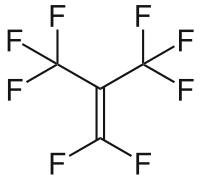Perfluoroisobutene
| Structural formula | ||||||||||||||||
|---|---|---|---|---|---|---|---|---|---|---|---|---|---|---|---|---|

|
||||||||||||||||
| General | ||||||||||||||||
| Surname | Perfluoroisobutene | |||||||||||||||
| other names |
|
|||||||||||||||
| Molecular formula | C 4 F 8 | |||||||||||||||
| Brief description |
colorless, non-flammable gas |
|||||||||||||||
| External identifiers / databases | ||||||||||||||||
|
||||||||||||||||
| properties | ||||||||||||||||
| Molar mass | 200.03 g mol −1 | |||||||||||||||
| Physical state |
gaseous |
|||||||||||||||
| boiling point |
7 ° C |
|||||||||||||||
| safety instructions | ||||||||||||||||
|
||||||||||||||||
| Toxicological data | ||||||||||||||||
| As far as possible and customary, SI units are used. Unless otherwise noted, the data given apply to standard conditions . | ||||||||||||||||
Perfluoroisobutene ( PFIB ) is a gaseous perfluorinated alkene .
properties
PFIB is a strong electrophile . In contact with water, it is rapidly hydrolyzed , forming various substances such as fluorophosgene .
use
In the Soviet Union the use of PFIB as a warfare agent was investigated. The simple production by heating polytetrafluoroethylene (PTFE) and the fact that protective masks with activated carbon filters are useless against PFIB made the gas interesting. Today, PFIB is banned under the Chemical Weapons Convention .
safety instructions
PFIB is about ten times more toxic than phosgene . Inhalation can lead to pulmonary edema . PFIB can arise during the pyrolysis of PTFE and trigger polymer fever .
Individual evidence
- ↑ a b c d Entry on perfluoroisobutylene in the GESTIS substance database of the IFA , accessed on February 1, 2016(JavaScript required) .
- ↑ a b c Jiri Patocka, Jiri Bajgar: Toxicology of Perfluoroisobutene. The ASA Newsletter, 1998, ISSN 1057-9419 .
- ^ A b Charles Edward Stewart: Weapons of Mass Casualties and Terrorism Response Handbook. Jones & Bartlett Learning, 2006, ISBN 978-0-763-72425-2 , p. 42 ( limited preview in Google Book Search).
- ^ Organization for the Prohibition of Chemical Weapons: Convention on the Prohibition of the Development, Production, Stockpiling and Use of Chemical Weapons and on their Destruction

